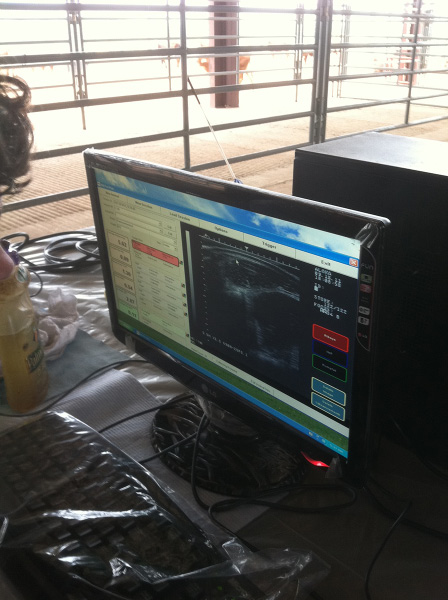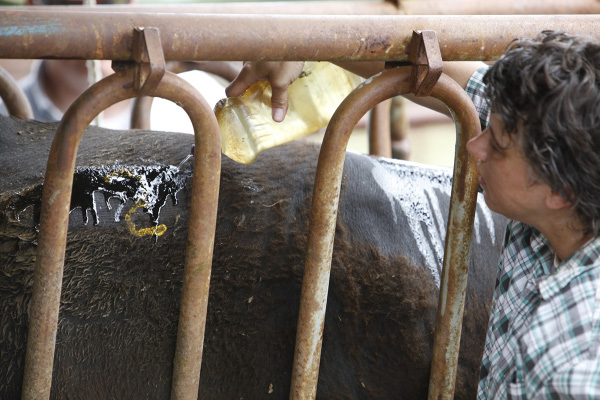Using Live Animal Carcass Ultrasound Information in Beef Cattle Selection
In some instances, value-based marketing systems can be economically advantageous to cattle producers. Monetary rewards are sometimes available for producing a high-quality, consistent end product that meets consumer demands. One tool that can help producers in the efficient and profitable production of beef cattle is live animal carcass ultrasound. This gives cattle producers the ability to make genetic improvements in carcass traits of their cattle, which may increase their profits.
Principles of Carcass Ultrasound
The ultrasound technology used for carcass trait measurement is referred to as real-time ultrasound. It uses high-frequency sound waves (generally 2 to 10 MHz) to display images of muscle and fat under a living animal’s hide. This is the same technology used for pregnancy diagnosis in both livestock and humans. This process is harmless to the animal and the technician.
This technology involves a sound-emitting probe, or transducer, placed on the animal’s back. The sound waves penetrate the tissues, reflecting off the boundaries between the hide, fat, and muscle layers. As the sound waves are reflected back toward the probe, a cross-sectional image is created on the ultrasound machine monitor, which allows measurement of the various carcass traits (Figure 1).

Measurements Collected
The measurements collected through live animal carcass ultrasound can be used to estimate carcass retail yield and meat quality. The common traits estimated include ribeye area (REA), rib fat (BF), rump fat (RF), and percent intramuscular fat (IMF%). Ribeye area, in square inches, is measured between the 12th and 13th ribs and gives an estimate of the amount of muscle and lean product in the animal. Rib fat (back fat), in inches, is also measured between the 12th and 13th ribs and is an estimate of the external fat on the animal. Rump fat is an additional measure of external fat on the animal and is also measured in inches. Percent intramuscular fat is an objective measure of marbling in cattle. Marbling is the main trait used in determining USDA quality grades and is a good indicator of the animal’s meat quality. For more information on these measurements, please see Mississippi State University Extension Publication 2509 Ultrasound Scanning Beef Cattle for Body Composition.

Using Carcass Ultrasound Data
Ultrasound carcass measurements are no different than traits like birth weight and yearling weight in that environmental conditions (such as nutrition) play a role in expression of these traits. Therefore, it is more desirable to make selection decisions based on relative differences within a contemporary group (carcass trait ratios) rather than the actual measurements. Better still is the use of ultrasound carcass expected progeny differences (EPDs), if they are available for the breed. Because ultrasound carcass traits are generally considered highly heritable, selection of replacement bulls and heifers or cows based on these traits will result in rapid genetic change in a herd.
Breeders should keep “common sense” in mind when developing a selection program that includes carcass traits. Ultrasound carcass EPDs can be used to make genetic changes, but concentrating solely on these traits and ignoring other production traits will certainly lead to problems. For example, continued selection against back fat will almost certainly result in reduced reproductive performance of the herd and could produce cattle that are “hard keepers.” In addition, ribeye area and mature size are genetically related so that selection emphasis for ribeye area will generally result in increased frame size, which could ultimately impact performance. There does not appear to be any major downside for the herd in response to selection for increased marbling. However, single-trait selection is not recommended.
Carcass Traits
Carcass traits can be measured either at harvest or on live animals using ultrasound. Many breeds report EPDs for carcass traits, using one type of measurement or a combination of both. All measure the expected performance of the animal’s progeny. Different breeds calculate EPDs for different traits. Most breeds use a constant age endpoint for carcass data; however, some breeds use a constant fat endpoint. Some breeds update interim EPDs after the bulls are scanned during a gain test, for example. Specific carcass EPDs and their descriptions are discussed next.
- Carcass weight (CW), expressed in pounds, is a predictor of the differences in hot carcass weight of an animal’s progeny compared to progeny of other animals of the same breed. Greater EPDs indicate heavier expected calf carcass weights.
- Marbling (Marb) is expressed as a fraction of the difference in the U.S. Department of Agriculture score of an animal’s progeny compared to the progeny of other animals within the same breed. A greater value will most likely result in greater progeny carcass quality and acceptance on a grid marketing basis.
- Ribeye area (RE), expressed in square inches, is a predictor of the difference in ribeye area of an animal’s progeny compared to the progeny of other animals within the breed. Greater values typically indicate progeny will have larger ribeyes.
- Fat thickness (Fat), expressed in inches, is a predictor of the differences in external fat thickness at the 12th rib (as measured between the 12th and 13th ribs) of an animal’s progeny compared to the progeny of other animals within the breed. Selection for less fat reduces the amount of trim needed at the packing plant and can increase the value of the animal due to an improvement in yield grade. However, animals with excessively low back fat can have problems with cold shortening in the cooler and could be less efficient in fleshing ability.
- Group/progeny (Grp/Pg) reflects the number of contemporary groups and carcasses included in the analysis for carcass EPD values.
- Yield grade is a measure of the relative proportion of closely trimmed, boneless retail cuts from an animal’s progeny.
- Percent retail cuts is a measure of the percentage of closely trimmed, boneless retail cuts from an animal’s progeny.
- Days to finish is a measure of the number of days required to reach the constant fat endpoint. Greater EPDs typically mean progeny will take longer to finish.
Ultrasound
- Intramuscular fat (%IMF) is a predictor of the difference in an animal’s progeny for percent intramuscular fat in the ribeye muscle compared to the progeny of other animals within the breed.
- Ribeye area (RE) is a predictor of the difference in square inches of ultrasound ribeye area of an animal’s progeny compared to the progeny of other animals within the breed.
- Fat thickness (Fat), expressed in inches, is a predictor of the difference in ultrasound fat thickness at the 12th rib of an animal’s progeny compared to the progeny of other animals within the breed. It includes the weighted average of 60 percent of the rib fat measurement and 40 percent of the rump fat measurement in some breeds.
- Group/progeny (Grp/Pg) is the number of contemporary groups and the number of progeny considered in the EPD analysis.

$ Selection Indices
Multi-trait selection indices, expressed in dollars per head, are available to assist beef producers by adding simplicity to genetic selection decisions. Each selection index is an estimate of how future progeny of each animal are expected to perform, on average, compared to progeny of other breeding animals in the database if the animals were randomly mated and if calves were exposed to the same environment. Selection indices are used to select for several traits at once. An index approach takes into account genetic and economic values to select for economic merit. Specific indices are presented next for several beef breeds. Bear in mind that selection index offerings change over time, so it is best to consult directly with the breed association for the breed of interest to determine what current selection indices are available for that particular breed.
Angus
- Feedlot value ($F), an index value expressed in dollars per head, is the expected average difference in progeny performance for post-weaning merit compared to progeny of other animals; the $F index incorporates weaning weight (WW) and yearling weight (YW) EPDs, along with trait interrelationships. Typical feedlot gain value, feed consumption, and cost differences are accounted for in the final calculations, along with a standard set of industry values for days on feed, ration costs, and cash cattle prices. The value of this performance measure is to predict average genetic differences in individuals, not to measure actual performance.
- Grid value ($G), an index value expressed in dollars per head, is the expected average difference in future progeny performance for carcass grid merit compared to progeny of other animals within the breed. The $G combines quality grade and yield grade attributes and is calculated for animals with carcass EPDs, ultrasound EPDs, or both types of EPDs. A three-year rolling average is used to establish typical industry economic values for quality and yield grade schedules. Quality grade premiums are specified for Prime, Certified Angus Beef (CAB), and Choice carcasses; Select and Standard discounts are also specified. Yield grade premiums are incorporated for YG 1 and YG 2 (high-yielding carcasses), with discounts for YG 4 and YG 5 (low red meat yields). Grid impact in dollars per hundredweight (cwt) and dollars per head is calculated from the yield grade and quality grade components and then combined to arrive at the $G.
- Quality grade ($QG) is the quality grade segment of the economic advantage found in $G; the $QG index is intended for the specialized user wanting to place more emphasis on improving quality grade. The carcass marbling (Marb) EPD and ultrasound-derived percent intramuscular fat (%IMF) EPD contribute to $QG.
- Yield grade ($YG) is the yield grade segment of the economic advantage found in $G; the $YG index is intended for the specialized user wanting to place more emphasis on red meat yield. It provides a multi-trait selection approach to encompass ribeye area, fat thickness, and carcass weight into an economic value for red meat yield.
- The $G index combines both $QG and $YG and may be the best carcass decision tool for focusing on quality and red meat yield simultaneously.
- Beef value ($B), an index value expressed in dollars per head, is the expected average difference in future progeny performance for post-weaning and carcass value compared to progeny of other animals.
Gelbvieh
- Carcass value (CV) is the expected average carcass value of future progeny when sold on a grid; it incorporates carcass weight, yield grade, and quality grade information.
- Feedlot merit (FM) is the expected average of future progeny for post-weaning feedlot performance.
Hereford
- Baldy Maternal Index (BMI$) maximizes profit for commercial cow-calf producers who use Hereford bulls in rotational crossbreeding programs on Angus-based cows; retained ownership of calves through the feedlot phase of production is maintained, and the cattle are to be marketed on a Certified Hereford Beef (CHB) pricing grid.
- Brahman Influence Index (BII$) uses Hereford bulls in a rotational crossbreeding system with Brahman and emphasizes fertility and age at puberty over growth; because Brahman cattle are not used in the CHB program, a commodity pricing grid is used.
- Certified Hereford Beef Index (CHB$) is a terminal sire index where Hereford bulls are used on British-cross cows and all offspring are sold as fed cattle on a CHB pricing grid; there is no emphasis on milk or fertility because all cattle will be terminal. This index includes growth and carcass information.
- Calving Ease Index (CEZ$) is used to select bulls that will be used in a heifer program; this index has increased emphasis on direct and maternal calving ease.
Limousin
- Mainstream Terminal Index ($MTI) is the expected average profit per carcass of progeny of Limousin bulls mated to British-cross cows, with all calves placed in the feedlot and sold on a mainstream grid; it is a terminal sire index, including growth and carcass information only, because all calves are marketed and no females remain in the herd.
Simmental and SimAngus
Accuracy
Most EPDs are reported with an accuracy (ACC) value, which ranges from zero to one. It is a measure of the reliability of the EPD. Expected progeny differences change and become more accurate as the breed association processes additional data on an animal and its relatives. For most yearling bulls, ACC is low because they have not sired any progeny. Some breeds report accuracy of these EPDs as interim or pedigree estimates (e.g., I, P, P+, or PE), and these designations indicate that the EPD is based on pedigree data or is an interim EPD based on pedigree data and the animal’s own performance information.
Ratios
If carcass EPDs are not available, ratios can be used. Ratios provide a way to rank animal performance within a contemporary group after age, weight, and sex adjustments have been taken into consideration. The average ratio within a contemporary group is 100, so any ratio above 100 represents greater but not necessarily more desirable performance depending on the trait, and any ratio below 100 indicates less than average performance. Although ratios are a convenient way to depict phenotypic information, they are limited in their ability to indicate an animal’s genetic merit because they do not take into account the animal’s pedigree information. Ratios should never be compared to ratios from different contemporary groups or to ratios from other breeds.
Adjusted Measurements
Adjusted measurements take an animal’s age, weight, and sex at ultrasound scanning into account. Adjusted measurements give an indication of an animal’s phenotype for a trait but give no means by which to compare the animal across contemporary groups or breeds. Like ratios, adjusted measurements are limited in their ability to indicate an animal’s genetic merit for a given trait.
Percentile Tables
Breed average EPDs for most traits are not zero. The actual breed average will vary by breed and change over time. Percentile tables can be used to determine where an animal’s EPDs and indices rank within a breed. The EPDs and selection indices for animals should be compared to animals within the same gender and parent designation. For example, non-parent bulls should be compared to percentiles for non-parent bulls of the same breed. Look up a bull’s EPD in the table to determine where he ranks within his breed. Percentile tables are available from the breed associations and will change with each new national cattle evaluation run with the addition of new performance information recorded.
Selection
An objective when purchasing a bull is to purchase an animal that will enhance the genetics of his offspring. Selection based on raw ultrasound scan data places selection pressure not only on the genetic potential of an animal but also on environmental influences (herd, year, season, management, etc.). Comparing two drastically different management scenarios (forage-tested bulls and high concentrate fed bulls), it would be expected that the bulls raised on high concentrate diets would have greater percent intramuscular fat values. The question remains: are the more desirable IMF scan figures due to genetics or to the fact that the animal received more feed? Consequently, selection based on EPDs will help sort out these environmental influences to quantify genetic differences.
In the following example, look only at the EPDs that relate to carcass merit (Table 1). For carcass weight, Bull B should produce calves that on average have one pound more adjusted carcass weight than those sired by Bull A. For marbling, Bull B should produce calves that have on average a 0.37 greater marbling score than Bull A’s calves. Ultrasound EPDs were calculated for a number of breeds for traits of ribeye area, fat, and intramuscular fat (IMF), which correlated to marbling; however, now the majority of breeds use these ultrasound measurements in the calculation of carcass EPDs. So, instead of having both IMF and marbling EPDs, only a marbling EPD is available, but it has ultrasound measurements included in this calculation.
|
Carcass EPD Information |
Bull A |
Bull B |
|---|---|---|
|
Carcass weight (CW) |
+29 |
+30 |
|
Marbling (Marb) |
+0.37 |
+0.74 |
|
Ribeye area (RE) |
+0.71 |
+1.23 |
|
Fat thickness |
-0.002 |
-0.012 |
|
Carcass group |
1 |
4 |
|
Ultrasound group |
452 |
852 |
|
Carcass progeny |
1 |
11 |
|
Ultrasound progeny |
1614 |
2593 |
For ribeye area, Bull B should produce calves that have 0.52 square inch larger ribeye on average relative to the calves sired by Bull A. For fat thickness, Bull A should produce calves that have on average 0.01 inch less fat when measured at the 12th rib compared with Bull B’s calves. Bull B should produce calves that on average have greater $QG(+11.9), $YG(+5.96), and $G(+17.86) potential versus the calves sired by Bull A (Table 2). Note that Bull B has three more contemporary groups incorporated into his carcass EPDs and 400 more contemporary groups incorporated into his ultrasound EPDs. Bull B has 10 more carcasses incorporated into his carcass EPDs and 979 more progeny incorporated into his ultrasound EPDs.
|
Selection Indices |
Bull A |
Bull B |
|---|---|---|
|
Quality grade ($QG) |
+21.84 |
+33.74 |
|
Yield grade ($YG) |
+9.34 |
+15.30 |
|
Grid value ($G) |
+31.18 |
+49.04 |
Implications
Breeders should keep a “common sense” approach in mind when selecting bulls or replacement heifers or cows and develop a selection program that includes economically relevant carcass traits. The economic relevance of carcass traits varies with different calf marketing approaches and market conditions. Ultrasound carcass EPDs can be used to make genetic changes, but concentrating solely on carcass traits while ignoring other production traits, especially reproductive traits, will lead to a herd that is less productive and profitable.
Real-time live animal carcass ultrasound can be a beneficial production practice for all segments of the beef industry. This technology is being used across the nation by progressive purebred and commercial bull producers and buyers as they integrate more carcass information into their selection programs. Using live animal carcass ultrasound is just one step toward the goal of producing a high-quality, consistent product for today’s value-based market. In addition, real-time ultrasound along with genetic testing only enhances the information on that animal and increases the accuracy of the EPD information.
The Mississippi Beef Cattle Improvement Association facilitates centralized ultrasound scanning services for interested beef cattle producers within the state. Contact information for this service is provided at http://extension.msstate.edu/agriculture/livestock/beef. For more information on beef cattle management, contact your local MSU Extension office.
References
American Angus Association. (2013). EPD definitions: Performance/AHIR®/BRS. St. Joseph, MO. http:www.angus.org.
American Gelbvieh Association. (2013). EPD Information. Westminister, CO. https://www.gelbvieh.org/genetic-technology/epd-info/.
American Hereford Association. (2013). Profit Index Fact Sheet. Kansas City, MO.
American Simmental Association. (2013). Sire Summary. Bozeman, MT.
Hicks, C. (2011). Using live animal carcass ultrasound in beef cattle. Bulletin 1337. The University of Georgia Cooperative Extension Service, Athens, GA.
Houghton, P. L., & Turlington, L. M. (1992). Application of ultrasound for feeding and finishing animals: A review. Journal of Animal Science, 70, 930–941.
North American Limousin Foundation. (2013). Genetics and Performance. Englewood, CO.
Parish, J. A., Rhinehart, J. D., & Vann, R. C. (2008). Ultrasound scanning beef cattle for body composition. Mississippi State University Extension Publication 2509. Mississippi State, MS.
Perkins, T., Meadows, A. & Hays, B. (2003). Study guide for the ultrasonic evaluation of beef cows for carcass merit. Ultrasound Guidelines Council.
Spangler, M. L. (2011). EPD basics and definitions. University of Nebraska-Lincoln Bulletin G1967.
Wall, P. (2011). Understanding the ultrasound info craze. http://www.cuplab.com/en/articles.cfm.
- All Purpose Index (API) is the expected average performance of progeny of Simmental bulls used on the entire Angus herd, with a portion of the daughters being retained for breeding and the remaining progeny being put on feed and sold grade and yield.
- Terminal Index (TI) is the expected average performance of progeny of Simmental bulls mated to Angus cows, with all offspring placed in the feedlot and sold on a grade and yield basis. It includes growth and carcass information only, because all progeny are marketed.
Publication 2082 (POD-10-20)
By Rhonda C. Vann, PhD, Research Professor, Animal and Dairy Sciences; Jane A. Parish, PhD, Professor and Head, North Mississippi Research and Extension Center; and Brandi B. Karisch, PhD, Associate Extension/Research Professor, Animal and Dairy Sciences.
The Mississippi State University Extension Service is working to ensure all web content is accessible to all users. If you need assistance accessing any of our content, please email the webteam or call 662-325-2262.





